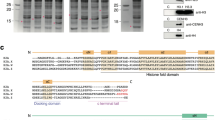Abstract
In plants with large genomes, each of the classes of the histones (H1, H2A, H2B, H3 and H4) are not unique polypeptides, but rather families of closely related proteins that are called histone variants. The small genome and preponderance of single-copy DNA in Arabidopsis thaliana has led us to ask if this plant has such families of histone variants. We have thus isolated histones from Arabidopsis and analyzed them on four polyacrylamide gel electrophoretic systems: an SDS system; an acetic acid-urea system; a Triton transverse gradient system; and a two-dimensional system combining SDS and Triton-acetic acid-urea systems. This approach has allowed us to identify all four of the nucleosomal core histones in Arabidopsis and to establish the existence of a set of H2A and H2B variants. Arabidopsis has at least four H2A variants and three H2B variants of distinct molecular weights as assessed by electrophoretic mobility on SDS-polyacrylamide gels. Thus, Arabidopsis displays a diversity in these histones similar to the diversity displayed by plants with larger genomes such as wheat.
The high mobility group (HMG) non-histone chromatin proteins have attracted considerable attention because of the evidence implicating them as structural proteins of transcriptionally active chromatin. We have isolated a group of non-histone chromatin proteins from Arabidopsis that meet the operational criteria to be classed as HMG proteins and that cross-react with antisera to HMG proteins of wheat.
Similar content being viewed by others
Abbreviations
- HMG:
-
high mobility group
- SDS:
-
sodium dodecyl sulfate
References
Allis CD, Richman R, Gorovsky MA, Ziegler YS, Touchstone B, Bradley WA, Cook RG: hvl is an evolutionarily conserved H2A variant that is preferentially associated with active genes. J Biol Chem 261: 1941–1948 (1986).
Allis CD, Glover CVC, Bowen JK, Gorovsky MA: Histone variants specific to the transcriptionally active, amitotically dividing macronucleus of the unicellular eucaryote, Tetrahymena thermophila. Cell 20: 609–617 (1980).
Chaboute MA, Chaubet N, Philipps G, Ehling M, Gigot C: Genomic organization and nucleotide sequences of two histone H3 and two histone H4 genes of Arabidopsis thaliana. Plant Mol Biol 8: 179–191 (1987).
Goodwin GH, Sanders C, Johns EW: A new group of chromatin-associated proteins with a high content of acidic and basic amino acids. Eur J Biochem 38: 14–19 (1973).
Isenberg I: Histones. Ann Rev Biochem 48: 159–191 (1979).
Johns EW: History, definitions and problems. In: Johns EW (ed) The HMG Chromosomal Proteins, pp. 1–7. Academic Press, London (1982).
Karpenchuk KG, Klimyuk VI: Identification of plant histones by nonionic detergent binding: The evolutionary argument. Mol Biol (Moscow) (English Trans.) 21: 813–822 (1987).
Kolodrubetz D, Rykowski MC, Grunstein M: Histone H2A subtypes associate interchangeably in vivo with histone H2B subtypes. Proc Natl Acad Sci USA 79: 7814–7818 (1982).
Langenbuch J, Philipps G, Gigot C: Fractionation and characterization of histones from barley (Hordeum vulgare) leaves. Plant Mol Biol 2: 207–220 (1983).
Leutwiler LS, Hough-Evans BR, Meyerowitz EM: The DNA of Arabidopsis thaliana. Mol Gen Genet 194: 15–23 (1984).
Lohr D, Hereford L: Yeast chromatin is uniformly digested by DNase I. Proc Natl Acad Sci USA 76: 4285–4288 (1979).
Matsudaira PT, Burgess DR: SDS microslab linear gradient polyacrylamide gel electrophoresis. Anal Biochem 87: 386–396 (1978).
Mayes ELV: Species and tissue specificity. In: Johns EW (ed) The HMG Chromosomal Proteins, pp. 9–40. Academic Press, London (1982).
Pruitt RE, Meyerowitz EM: Characterization of the genome of Arabidopsis thaliana. J Mol Biol 187: 169–183 (1986).
Rodrigues J, Brandt WF, Von Holt C: Plant histone 2 from wheat germ, a family of histone H2A variants: partial amino acid sequences. Biochim Biophys Acta 579: 196–206 (1979).
Rodrigues J, Brandt WF, Von Holt C: The amino acid sequence of wheat histone H2A(1): a core histone with a C-terminal extension. Eur J Biochem 150: 499–506 (1985).
Rykowski MC, Wallis JW, Choe J, Grunstein M: Histone H2B subtypes are dispensable during the yeast cell cycle. Cell 25: 477–487 (1981).
Simon JH, Becker WM: A polyethylene glycol/dextran procedure for the isolation of chromatin proteins (histones and non-histones) from wheat germ. Biochim Biophys Acta 454: 154–171 (1976).
Simpson RT: Modulation of nucleosome structure by histone subtypes in sea urchin embryos. Proc Natl Acad Sci USA 78: 6803–6807 (1981).
Spiker S: A modification of the acetic-acid urea system for use in microslab polyacrylamide gel electrophoresis. Anal Biochem 108: 263–265 (1980).
Spiker S: Histone variants in plants. J Biol Chem 257: 14250–14255 (1982).
Spiker S: High-Mobility Group chromosomal proteins of wheat. J Biol Chem 259: 12007–12013 (1984).
Spiker S: Histones and HMG proteins of higher plants. In: Kahl G (ed) Architecture of Eukaryotic Genes, pp. 143–162. VCH Verlagsgesellschaft, Weinheim (1988).
Spiker S, Key JL, Wakim B: Identification and fractionation of plant histones. Arch Biochem Biophys 176: 510–518 (1976).
Spiker S, Mardian JKW, Isenberg I: Chromosomal HMG proteins occur in three eukaryotic kingdoms. Biochem Biophys Res Commun 82: 129–135 (1978).
Spiker S, Everett KM: Blotting index of dissimilarity: use to study immunological relatedness of plant and animal high mobility group (HMG) chromosomal proteins. Plant Mol Biol 9: 431–442 (1987).
Spiker S, Hopkins R, Fischer R, Quatrano R: Synthesis of nucleosomal histone variants during wheat grain development. Biochim Biophys Acta 910: 157–162 (1987).
Vincentz M, Gigot C: HMG-like protein in barley and corn nuclei. Plant Mol Biol 4: 161–168 (1985).
Waterborg JH, Winicov I, Harrington RH: Histone variants and acetylated species from the alfalfa plant Medicago sativa. Arch Biochem Biophys 256: 167–178 (1987).
Weisbrod S: Active chromatin. Nature (London) 297: 289–295 (1982).
Wu RS, Panusz HT, Hatch CT, Bonner WM: Histones and their modifications. Crit Rev Biochem 20: 201–263 (1986).
Zweidler A: Resolution of histones by polyacrylamide gel electrophoresis in the presence of nonionic detergents. Methods Cell Biol 17: 223–233 (1978).
Author information
Authors and Affiliations
Additional information
This is paper 11628 of the Journal Series of the North Carolina Agricultural Research Service, Raleigh, NC 27695
Rights and permissions
About this article
Cite this article
Moehs, C.P., McElwain, E.F. & Spiker, S. Chromosomal proteins of Arabidopsis thaliana . Plant Mol Biol 11, 507–515 (1988). https://doi.org/10.1007/BF00039031
Received:
Accepted:
Issue Date:
DOI: https://doi.org/10.1007/BF00039031




